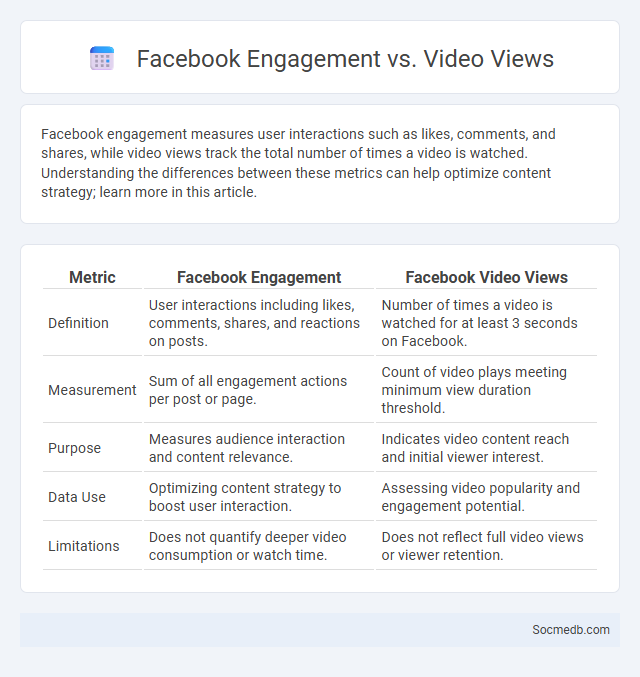
Photo illustration: Facebook Engagement vs Video Views
Facebook engagement measures user interactions such as likes, comments, and shares, while video views track the total number of times a video is watched. Understanding the differences between these metrics can help optimize content strategy; learn more in this article.
Table of Comparison
| Metric | Facebook Engagement | Facebook Video Views |
|---|---|---|
| Definition | User interactions including likes, comments, shares, and reactions on posts. | Number of times a video is watched for at least 3 seconds on Facebook. |
| Measurement | Sum of all engagement actions per post or page. | Count of video plays meeting minimum view duration threshold. |
| Purpose | Measures audience interaction and content relevance. | Indicates video content reach and initial viewer interest. |
| Data Use | Optimizing content strategy to boost user interaction. | Assessing video popularity and engagement potential. |
| Limitations | Does not quantify deeper video consumption or watch time. | Does not reflect full video views or viewer retention. |
Understanding Facebook Engagement: Definition and Metrics
Facebook engagement refers to the total interactions users have with content, including likes, comments, shares, and clicks. Key metrics such as engagement rate, reach, and impressions help measure how effectively content resonates with the audience. Analyzing these metrics provides insights into user behavior and content performance, enabling better social media strategies.
What Are Video Views on Facebook?
Video views on Facebook represent the number of times your video content is watched by users, with Facebook counting a view after just three seconds of playback. This metric helps gauge audience engagement and the reach of your video campaigns, providing insights into viewer interest and content effectiveness. Monitoring video views enables you to adjust strategies for higher visibility and improved connection with your target audience.
Engagement vs Video Views: Key Differences
Engagement measures the interactions your audience has with your social media content, including likes, comments, shares, and clicks, reflecting the quality of user connection. Video views count the number of times your video is watched, offering a quantitative metric of reach but not necessarily viewer interest or interaction. Understanding the distinction between engagement and video views helps you optimize your content strategy to foster meaningful interactions rather than just increasing visibility.
Why Facebook Engagement Matters for Brands
Facebook engagement--measured through likes, comments, shares, and reactions--directly influences a brand's organic reach and visibility within its target audience. Higher engagement signals to Facebook's algorithm that content is relevant and valuable, increasing the likelihood of it appearing in users' news feeds. Brands with strong Facebook engagement build community trust, foster customer loyalty, and drive more conversions by encouraging active participation and authentic interactions.
Video Views: Measuring Real Impact or Vanity Metric?
Video views on social media platforms often serve as a quick indicator of content reach, but they don't always reflect genuine engagement or conversion rates. True impact is better measured by metrics such as watch time, viewer retention, comments, and shares, which reveal how your audience interacts with and values your videos. To maximize your social media strategy, focus on these deeper analytics rather than relying solely on superficial video view counts.
Engagement Metrics: Likes, Comments, and Shares Explained
Engagement metrics such as likes, comments, and shares are critical indicators of social media success, reflecting user interaction and content resonance. Likes serve as quick affirmation, measuring content popularity, while comments provide deeper insights into audience sentiment and foster community dialogue. Shares amplify content reach by allowing users to distribute posts across their networks, significantly enhancing organic visibility and brand awareness.
How Facebook’s Algorithm Values Engagement vs Video Views
Facebook's algorithm prioritizes engagement such as comments, shares, and reactions over mere video views to determine content visibility. Your posts that generate meaningful interactions are more likely to be promoted in users' newsfeeds, enhancing organic reach and community building. Videos with high engagement rates signal relevance, thus outperforming those that accumulate views without active participation.
Strategies to Boost Facebook Engagement
To boost Facebook engagement effectively, focus on creating visually appealing content such as high-quality images and videos that resonate with your target audience. Utilize Facebook Insights to analyze your audience's behavior and post during peak hours to maximize reach. Encourage Your followers to interact by asking questions, running polls, and responding promptly to comments to foster a sense of community.
Improving Video Views Without Sacrificing Engagement
To improve video views without sacrificing engagement, prioritize creating high-quality, relevant content tailored to Your target audience's interests and preferences. Optimize video titles, descriptions, and tags with targeted keywords to enhance discoverability across social media platforms. Encourage active interaction through compelling calls-to-action, prompting viewers to comment, share, and like to boost algorithmic promotion and sustained engagement.
Choosing the Right Metric for Your Facebook Campaign Goals
Selecting the right metric for your Facebook campaign goals ensures accurate measurement of success and informs strategic adjustments. You should align key performance indicators (KPIs) such as reach, engagement rate, click-through rate (CTR), or conversion rate directly with your specific campaign objectives, whether brand awareness or sales. Monitoring relevant Facebook Insights data helps optimize ad spend and maximize return on investment (ROI).
 socmedb.com
socmedb.com